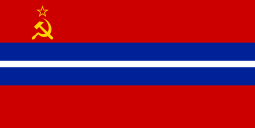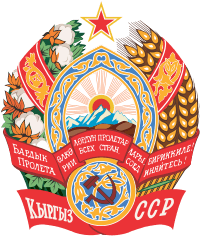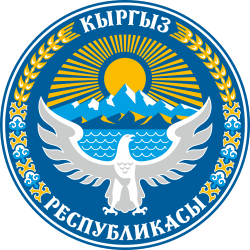Kirghiz Soviet Socialist Republic
Kirghizia,[2] officially the Kirghiz Soviet Socialist Republic (Kirghiz SSR; Kyrgyz: Кыргыз Советтик Социалисттик Республикасы Qırğız Sovettik Sotsialisttik Respublikası; Russian: Киргизская Советская Социалистическая Республика Kirgizskaya Sovetskaya Sotsialisticheskaya Respublika) and the Republic of Kirghizia, also referred to as Soviet Kirghizia,[3] was one of the constituent republics of the Soviet Union (USSR) from 1936 to 1991.
Kirghiz Soviet Socialist Republic[1] | |||||||||
|---|---|---|---|---|---|---|---|---|---|
| 1936–1991 | |||||||||
Motto: Бардык өлкөлөрдүн пролетарлары, бириккиле! (Kyrgyz) Bardıq ölkölördün proletarları, birikkile! (transliteration) "Workers of all nations, unite!" | |||||||||
Anthem: Кыргыз Советтик Социалисттик Республикасы Мамлекеттик Гимни Qırğız Sovettik Sotsialisttik Respublikası Mamlekettik Gimni "Anthem of the Kirghiz Soviet Socialist Republic" (1946–1991) | |||||||||
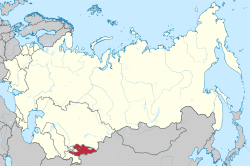 Location of Kirghizia (red) within the Soviet Union | |||||||||
| Status | Soviet Socialist Republic | ||||||||
| Capital | Frunze | ||||||||
| Common languages | Official languages: Kirghiz · Russian Minority languages: Uzbek | ||||||||
| Demonym(s) | Kirghiz Soviet | ||||||||
| Government | Unitary Marxist-Leninist single-party soviet republic (1936–1990) Unitary presidential republic (1990–1991) | ||||||||
| Leader | |||||||||
• 1936–1937 | Moris Belotsky (first) | ||||||||
• 1985–1991 | Absamat Masaliyev (last) | ||||||||
| Head of state | |||||||||
• 1936–1937 | Abdukadyr Urazbekov (first) | ||||||||
• 1990–1991 | Askar Akayev (last) | ||||||||
| Premier | |||||||||
• 1936–1937 | Bayaly Isakeyev (first) | ||||||||
• 1986–1991 | Apas Jumagulov (last) | ||||||||
| Legislature | Supreme Soviet | ||||||||
| History | |||||||||
• Kirghiz ASSR formed | 11 February 1926 | ||||||||
• Elevation to a Union Republic | 5 December 1936 | ||||||||
| June 1990 | |||||||||
• Sovereignty declared | 30 December 1990 | ||||||||
• Independence declared | 31 August 1991 | ||||||||
• Independence recognized | 26 December 1991 | ||||||||
| Area | |||||||||
| 1989 | 198,500 km2 (76,600 sq mi) | ||||||||
| Population | |||||||||
• 1989 | 4,257,800 | ||||||||
| Currency | Soviet ruble (руб) (SUR) | ||||||||
| Calling code | 7 319/331/332/334/335 | ||||||||
| |||||||||
| Today part of | Kyrgyzstan | ||||||||
Landlocked and mountainous, it bordered Tajikistan and China to the south, Uzbekistan to the west and Kazakhstan to the north. The Kirghiz branch of the Communist Party of the Soviet Union governed the republic from 1936 until 1990.
On 15 December 1990, the Kirghiz SSR was renamed to Socialist Republic of Kirghizia after declaring its state sovereignty. On 31 August 1991, it transformed into independent Kyrgyzstan.
Etymology
The name "Kyrgyz" is believed to have been derived from the Turkic word for "forty", in reference to the forty clans of Manas, a legendary hero who united forty regional clans against the Uyghurs. The name "Kyrgyz" or "Kirghiz" means "Land of the forty tribes", combined from three words: kyrg (kırk) meaning "forty", yz (uz) meaning "tribes" in East-Turkic, and -stan meaning "land" in Persian.[4] Politically, the name of the republic was the Kirghiz Soviet Socialist Republic as stated in the 1937 and 1978 Constitutions of the Kirghiz SSR.
From 30 October 1990 to 15 December 1990, it was renamed the Socialist Republic of Kirghizia (or Kyrgyzstan). Afterwards, the "Socialist" prefix was dropped and it became the Republic of Kirghizia, which retained this name after independence.[1]
History
| Eastern Bloc | |||||||
|---|---|---|---|---|---|---|---|
 | |||||||
|
Allied states
|
|||||||
|
Related organizations |
|||||||
|
Dissent and opposition
|
|||||||
Part of a series on the |
|---|
| History of Kyrgyzstan |
 |
Established on 14 October 1924 as the Kara-Kirghiz Autonomous Oblast of the RSFSR, it was transformed into the Kirghiz ASSR (Kirghiz Autonomous Socialist Soviet Republic) on 1 February 1926, still being a part of the RSFSR.[5] The borders were not divided however by ethnic or linguistic lines.[6]
On 5 December 1936, with the adoption of the 1936 Soviet Constitution, it became a separate constituent republic of the USSR as the Kirghiz Soviet Socialist Republic during the final stages of the national delimitation in the Soviet Union.[7]
At the time of formation of Kirghizia, its territory was divided into districts. On November 21, 1939 five oblasts (regions) were created: Jalal-Abad, Issyk Kul, Osh, Tyan Shan, and Frunze Oblasts.[8][9] Tyan Shan Oblast was abolished in 1962, when the rest of the country with the exception of Osh was divided into districts of republican subordination. In 1970, Issyk-Kul and Naryn (formerly Tien Shan) were defined, and in 1980 so was Talas. In 1988, the Naryn and Talas oblasts were again abolished, but in 1990 they were restored. At the same time, Jalal-Abad and Chui (formerly Frunze) were reestablished. These districts were particularly known for their heavy application of fertilizers after independence.[10]
The Osh Massacre in 1990 undermined the position of the first secretary. That same year, on 15 December, the Kirghiz SSR was reconstituted as the Republic of Kyrgyzstan after declaring its sovereignty. On 17 March 1991, Kirghizia supported the Union preservation referendum with a 95.98% turnout.
However, this did not come to pass when the hardliners took control of Moscow for three days in August 1991. Askar Akayev, the first president, unequivocally condemned the putsch and gained fame as a democratic leader. The country declared its independence on 31 August 1991 and the Soviet Union was formally dissolved on 26 December 1991.[11] However, the 1978 constitution remained in effect after its independence until 1993.
Politics
Similar to that of the Soviet republics, Kirghizia's government took place in the framework of a one-party socialist republic with the Communist Party of Kirghizia as the sole legal political party. The First Secretary of the Communist Party of Kirghizia served as the head of the party, while the Chairmen of the Presidium of the Supreme Soviet functioned as the executive head of state and the Chairmen of the Council of Ministers led the legislative branch.
Economy
Demographics
In 1926, the Kirghiz Soviet Socialist Republic had a population of 1,002,000 people. In 1939, 1,458,000 people were recorded. The population grew significantly in the decades after World War II; the republic had 2,065,837 people in 1959, 2,932,805 people in 1970, and 3,529,030 people in 1979. In the final Soviet census of 1989, the Kirghiz Soviet Socialist Republic had grown to 4,257,755 people.[12] The majority of the population were ethnic Kyrgyz people. However, because large numbers were sent here in deportations, at times there were significant other ethnic groups. Between March and May 1944 alone, it was reported in the Kremlin that 602,193 residents of the North Caucasus region had been deported to the Kirghiz and Kazakh SSRs, of which 496,460 were Chechens and Ingush, 68,327 of which were Karachai and 37,406 were Balkars.[13] The majority of the Kyrgyz population were (as they are today) Muslims, speaking a Turkic language. Bishkek had the largest concentration of Russians in the country, some 22% of the population by independence, with Uzbek minorities in the Fergana Valley especially constituting some 13% of the population. In 1990, violent clashes between Uzbeks and Kyghyz peoples broke out in the Osh Raion; ethnic tension still remains in the region.[14]
Religion
Under Soviet rule, Islam in Kirghizia was heavily suppressed with people actively encouraging atheism. Soviet authorities permitted limited religious activity in all the majority-Muslim Soviet republics. Most of the Russian population of Kirghizia were atheist or Russian Orthodox. After independence, the country enjoyed greater religious freedom and remains to this day a secular state.
Geography
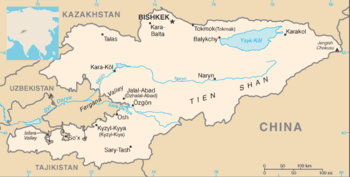
Kirghizia, a landlocked republic in Soviet Central Asia shared its borders with Kazakhstan, Tajikistan and Uzbekistan as well as China on the outside lying between latitudes 39° and 44° N, and longitudes 69° and 81° E. It is farther from the sea than any other individual country, and all its rivers flow into closed drainage systems which do not reach the sea. The mountainous region of the Tian Shan covers over 80% of the country,[15] with the remainder made up of valleys and basins.
Issyk-Kul Lake, or Ysyk-Köl in Kyrgyz, in the north-eastern Tian Shan is the largest lake in Kyrgyzstan and the second largest mountain lake in the world after Titicaca. The highest peaks are in the Kakshaal-Too range, forming the Chinese border. Peak Jengish Chokusu, at 7,439 m (24,406 ft), is the highest point and is considered by geologists to be the northernmost peak over 7,000 m (22,966 ft) in the world. Heavy snowfall in winter leads to spring floods which often cause serious damage downstream. The runoff from the mountains is also used for hydro-electricity.
Culture
As the Soviet Union respected other cultures even after delimitation, there are a wide variety of cultural items in Kirghizia listed here:
- Manas, an epic poem
- Komuz, a three-stringed lute
- Tush kyiz, large, elaborately embroidered wall hangings
- Shirdak, flat cushions made in shadow-pairs[16]
- Other textiles, especially made from felt
- Falconry
Traditions
Apart from celebrating the New Year each 1 January, Kirghizia, like all Soviet Republics, observed the Great October Socialist Revolution on 7 November. Its festivals and traditions such as Nowruz and Ulak Tartish were suppressed by the Soviet authorities.
The tradition of bride kidnapping, remains illegal to this day, was suppressed by the Soviet regime.[17] It is debatable whether bride kidnapping is actually traditional. Some of the confusion may stem from the fact that arranged marriages were traditional, and one of the ways to escape an arranged marriage was to arrange a consensual "kidnapping."[18]
References
- A Political Chronology of Central, South and East Asia. From 15 October 1990 to 15 December 1990, it was named the Socialist Republic of Kirghizia.
- From 1990 onwards, it was referred to as Kyrgyzstan.
- Nelson World Atlas, A Metric Atlas - Nelson, 1974
- Forty tribes and the 40-ray sun on the flag of Kyrgyzstan Archived 2009-10-07 at the Wayback Machine, SRAS–The School of Russian and Asian Studies
- Bennigsen, Alexandre; Broxup, Marie (3 June 2014). The Islamic Threat to the Soviet State (Routledge Revivals). Routledge. pp. 42–. ISBN 978-1-317-83171-6.
- Dana, Leo Paul (1 January 2002). When Economies Change Paths: Models of Transition in China, the Central Asian Republics, Myanmar & the Nations of Former Indochine Française. World Scientific. p. 65. ISBN 978-981-277-745-4.
- Group, Taylor & Francis (2004). Europa World Year. Taylor & Francis. p. 2543. ISBN 978-1-85743-255-8.
- Kirghiz Soviet Socialist Republic in the Great Soviet Encyclopedia, 1969–1978 (Russian)
- Incorporated, Grolier (1993). Encyclopedia Americana. Grolier Incorporated. p. 141. ISBN 9780717201242.
- Mudahar, Mohinder S. (1 January 1998). Kyrgyz Republic: Strategy for Rural Growth and Poverty Alleviation. World Bank Publications. p. 86. ISBN 978-0-8213-4326-5.
- Sakwa, Professor of Russian and Foreign Policy Richard; Sakwa, Richard (17 August 2005). The Rise and Fall of the Soviet Union. Routledge. p. 480. ISBN 978-1-134-80602-7.
- Pavlenko, Aneta (2008). Multilingualism in Post-Soviet Countries. Multilingual Matters. p. 206. ISBN 978-1-84769-087-6.
- Tishkov, Valery Aleksandrovich (15 May 2004). Chechnya: Life in a War-Torn Society. University of California Press. p. 25. ISBN 978-0-520-93020-9.
- Rubin, Don; Pong, Chua Soo; Chaturvedi, Ravi; Ramendu Majumdar; Minoru Tanokura (January 2001). The World Encyclopedia of Contemporary Theatre: Asia/Pacific. Taylor & Francis. p. 274. ISBN 978-0-415-26087-9.
- Escobar, Pepe (26 March 2005). "The Tulip Revolution takes root". Asia Times Online.
- Aidar, Iliyas. "Kyrgyz Style – Production – Souvenirs". Kyrgyzstyle.kg. Archived from the original on 11 November 2006. Retrieved 2 May 2010.
- Lom, Petr (March 2004). "Synopsis of "The Kidnapped Bride"". Frontline/World.
- "Reconciled to Violence: State Failure to Stop Domestic Abuse and Abduction of Women in Kyrgyzstan". Human Rights Watch Report. September 2006, Vol. 18, No.9.
